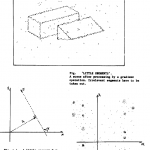Sehr nette Idee. Müsste man nur noch herausfinden wie man diese Cluster erkennt.
SOME ASPECTS OF PATTERN RECOGNITION BY COMPUTER
by ADOLFO GUZMAN-ARENAS
B.S., Instituto Politecnico Nacional (Mexico), 1965;
"The alpha-Lambda transformation.
The following scheme is useful in detecting undesired lines when dealing with rectliniear bodies. Given an array containing elementary segments (a small number of points plus a direction associated to them), as indicate in figure 'LITTE SEGMENTS', as we associate with each segment a pair of numbers, alpha is the angle that this segment forms with the x-axis, and lambda if the distance of the (extended) line from the origin.
That is to say, we convert the figure to an array of points (see figure 'CLUSTERING'). In the alpha-lambda space, points which fall close together are over the same line, so that frequency count will eliminate the spurious segments, as desired. Clouds with the same alpha are parallel lines, and this fact could be used in order to look for parallel lines.
Smooth curved lines could also be detected by this method, if we use a fancier criteria for the detection of clusters (1).
(1) Work in the area is:
1. Evan L. Ivie. PhD Thesis [18].
2. Probably a conventional pattern clasifier will do it. See N. J. Nilsson [26].
[18] Ivie, E. L., Search Procedures based on Measure of Relatedness Between Documents, Project MAC Technical Report MAC-TR-29 (M.I.T. Ph.D. Thesis), June 1966.
[26] Nilsson, N.J., Learning Machines, McGraw Hill, 1965."
